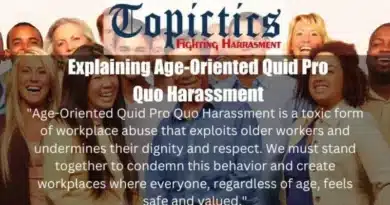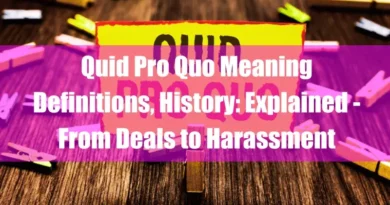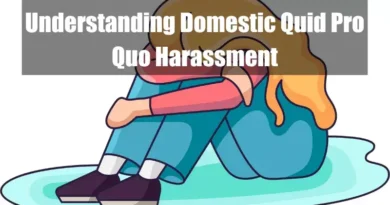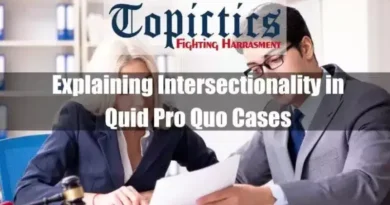The Evolution of Quid Pro Quo Harassment Policies
Takeaways
| Key Points |
|---|
| Quid pro quo, meaning “this for that,” refers to exchanges where job benefits are conditioned on submission to sexual advances. |
| Before the Civil Rights Act of 1964, limited legal protections created a culture of silence regarding workplace harassment. |
| The EEOC began recognizing sexual harassment as a form of sex discrimination under Title VII in the 1970s, with pivotal cases like Tomkins v. Public Service Electric and Gas Co. shaping the legal framework. |
| Title VII of the Civil Rights Act (1964) established a foundation for addressing quid pro quo harassment, reinforced by cases like Williams v. Saxbe and Barnes v. Costle. |
| Decisions such as Meritor Savings Bank v. Vinson (1986) expanded the interpretation of Title VII, holding employers accountable for preventing supervisor harassment. |
| Legal precedents extended employer liability to non-supervisors and clarified the overlap of quid pro quo and hostile work environment claims. |
| Contemporary challenges include technology-facilitated harassment and implicit quid pro quo pressures, which are harder to identify and address. |
| Comprehensive policies, updated training, and legislative reforms aim to prevent harassment and adapt to evolving workplace dynamics globally. |
Introduction
A. Historical Context and Legal Precedents
The Latin term “quid pro quo” translates to “this for that” and applies to situations where something is offered in exchange for something else. In the context of harassment, the term refers to unwelcome sexual advances or requests for sexual favors that are conditioned on job benefits or job security.
Before the Civil Rights Act of 1964, there were limited legal protections against workplace harassment. Employees facing harassment often had no recourse, and social norms frequently tolerated or ignored offensive behavior. This created a culture of silence where victims felt unable to speak up.
The fight for legal recognition of sexual harassment began in the mid-20th century. While not directly addressing quid pro quo harassment, cases like Tomkins v. Public Service Electric and Gas Co. (1977) laid the groundwork by establishing a “hostile work environment.”
The landmark case for hostile work environment harassment came in the 1980s with Meritor Savings Bank v. Vinson (1986). Mechelle Vinson, a bank teller, faced repeated sexual advances from her supervisor, Sidney Taylor, creating a pervasively hostile work environment. The Supreme Court’s ruling in Vinson’s favor established that severe or pervasive unwelcome sexual conduct could constitute illegal sexual harassment under Title VII of the Civil Rights Act.
B. Key Elements and Distinctions from Hostile Work Environment
In contrast to hostile work environments, claims of quid pro quo harassment present a clear exchange. The perpetrator (typically someone in a position of power) offers or threatens tangible benefits like promotions, raises, or continued employment in exchange for sexual favors or submission to unwanted advances. This power imbalance creates a coercive situation where the victim feels pressured to comply to avoid adverse consequences.
In quid pro quo situations, the focus is on the explicit exchange and its impact on the victim’s employment status. In hostile work environment cases, the emphasis is on the overall, pervasive nature of the offensive conduct and its ability to create a hostile or intimidating atmosphere for the victim and potentially others.
The consequences of quid pro quo harassment extend far beyond the immediate discomfort and violation experienced by the victim. Individuals subjected to this abuse often suffer lasting emotional and psychological harm, including anxiety, depression, and post-traumatic stress disorder. Decreased productivity, career setbacks, and job loss can compound financial and emotional burdens.
The ramifications for the workplace are equally significant. Quid pro quo harassment can lead to decreased morale, increased employee turnover, and decreased overall productivity.
Employers can face significant legal repercussions, including financial penalties and reputational damage, if they fail to address the issue adequately.
Early Recognition and Legal Framework

A. Pre-Civil Rights Era: A Murky Landscape for Quid Pro Quo Recognition
Prior to the transformative Civil Rights Act of 1964, the legal and social landscape regarding workplace harassment was a desolate wasteland. Limited protections and ambiguous definitions left individuals, particularly women and minority groups, vulnerable to abuse with little recourse. To truly grasp the evolution of quid pro quo policies, we must first navigate this era of shadows.
1. Social and Legal Landscape:
Imagine a world where “sexual harassment” wasn’t even a recognized term, let alone a punishable offense. The pre-1964 workplace was rife with a “boys’ club” mentality, where unwanted advances and predatory behavior were often tolerated, downplayed, or even normalized. Legal protections were scarce and woefully inadequate. Title VII of the Civil Rights Act, the cornerstone of federal anti-discrimination law, lay dormant, awaiting its legislative birth in 1964.
The 1970s witnessed a shift in the legal tide. The Equal Employment Opportunity Commission (EEOC) began recognizing sexual harassment as a form of sex discrimination under Title VII, albeit without specific guidelines. This opened the door for landmark cases to redefine the landscape.
In 1977, in Tomkins v. Public Service Electric and Gas Co., Adrienne Tomkins, a company clerk, faced quid pro quo harassment, where her supervisor made her job advancement contingent upon submission to his sexual advances. This case played a role in the legal evolution of sexual harassment claims under Title VII, highlighting the coercive use of authority for personal gain and contributing to the broader recognition of such conduct as violating workplace discrimination laws.
B. Establishment of Title VII and the Rise of Quid Pro Quo

The year 1964 marked a watershed moment in the fight against workplace harassment. The signing of the Civil Rights Act, with its groundbreaking Title VII, finally offered legal armor to those facing discrimination based on sex, race, color, religion, and national origin. For victims of quid pro quo harassment, it was a dawn breaking after a long night.
1. Title VII and the First Glimpse of Quid Pro Quo:
While Title VII didn’t explicitly mention “sexual harassment,” it empowered the EEOC to interpret its broad “sex discrimination” provision. This opened the door for a legal evolution that would eventually solidify the concept of quid pro quo.
The first rays of recognition shone in 1976 with Williams v. Saxbe. Paulette Barnes, a federal employee, faced persistent sexual advances from her superior. Though ultimately unsuccessful, Barnes’ case presented one of the earliest blueprints for addressing quid pro quo harassment under Title VII.
It’s important to note that While Williams’ case wasn’t successful, it did contribute to the legal development of recognizing this type of harassment.
2. Barnes v. Costle: Defining the Quagmire:
In 1977, Brenda Barnes, a clerk for the Environmental Protection Agency, faced unwelcome sexual advances from her supervisor, Benjamin Costle, who pressured her for favors in exchange for a promotion. Barnes v. Costle became a landmark decision in the D.C. Circuit Court. While earlier cases likely contributed to the concept, this case significantly solidified the legal understanding of quid pro quo harassment. The court emphasized the seriousness of such conduct, highlighting the exchange of sexual favors for tangible job benefits, such as promotions. It’s important to note that quid pro quo harassment can also involve implicit threats or conditions. Even if not explicitly stated, a supervisor creating a situation where job security feels dependent on sexual favors can be illegal.
3. Ripple Effects and Expanding Boundaries:
Barnes v. Costle significantly impacted the legal landscape. Cases like Garnier v. Chevron USA, Inc. (1984) and Brunner v. Trans World Airlines, Inc. (1982) further developed the legal understanding of quid pro quo harassment. Notably, Brunner v. TWA expanded the definition beyond supervisors, recognizing it could occur between coworkers with power imbalances.
The Equal Employment Opportunity Commission (EEOC) issued guidelines, and court rulings helped refine the legal framework. These addressed “tangible job benefits” and “implicit threats.”
However, the fight for a safe work environment continued. The line between quid pro quo and hostile work environment harassment remained unclear, and victims faced challenges in proving their cases. The next stage in legal evolution would require tackling these complexities and expanding employee protections.
Expansion and Refinement of the Concept
A. Power Imbalance and Expanding Horizons: Refining Quid Pro Quo
The recognition of quid pro quo harassment wouldn’t have blossomed without defining the inherent power imbalance at its core. This section focuses on how cases like Meritor Savings Bank v. Vinson and legal interpretations clarified who holds power, who is vulnerable, and the scope of employer responsibility.
1. Employer Liability: Holding the Gatekeepers Accountable
The ripple effects of Vinson reached far beyond individual cases. Courts began interpreting Title VII more broadly, holding employers accountable for failing to take reasonable steps to prevent or address supervisor harassment. This included:
- Implementing effective anti-harassment policies and training programs
- Establishing clear complaint procedures and investigative mechanisms
- Taking prompt and appropriate action against harassers
These rulings shifted the landscape, making employers active gatekeepers and forcing them to create safe workplaces for all employees, regardless of their position.
While early legal battles focused on quid pro quo sexual harassment, the legal landscape around quid pro quo harassment is still evolving. There have been discussions and some legal arguments regarding applying quid pro quo to other protected categories under Title VII, such as race, religion, and national origin. However, these areas are not as firmly established as quid pro quo sexual harassment.
B. Blurring the Lines: Quid Pro Quo Beyond the Traditional Setting

As legal frameworks around quid pro quo harassment solidified, the traditional supervisor-subordinate dynamic crumbled. New challenges emerged, forcing courts and policymakers to acknowledge the complex and nuanced ways power imbalances could play out in different workplace settings. Let’s dive into three key areas where the lines blurred:
1. Non-Employees and the Faragher v. Boca Raton Case (1998):
The workplace is sometimes a closed ecosystem. Two lifeguards, Holly Bates and Sue Faragher, faced sexual harassment from their supervisor, Bill Terry, who was a franchise owner. Terry wasn’t employed by the same legal entity (Boca Raton) as the lifeguards. He may have been considered an independent contractor or franchise owner with a contractual relationship with Boca Raton. Despite this complex contractual relationship, the Supreme Court, in Faragher v. Boca Raton, held the employer liable for failing to prevent the harassment. This landmark case extended employer responsibility beyond traditional organizational boundaries.
2. Addressing Quid Pro Quo in Hostile Work Environment Claims:
Quid pro quo harassment and hostile work environments can coexist in some situations. While Barnes v. Costle (1977) was a significant case for quid pro quo harassment, legal recognition of both forms of harassment emerged around the same time period. Cases like Harris v. Forklift Systems, Inc. (1993) further clarified the distinction between these two types of harassment. It emphasized that a hostile work environment can be created through severe or pervasive unwelcome sexual conduct, even without an explicit quid pro quo exchange.
C. Evolution in Action
These landmark cases illustrate the dynamic nature of quid pro quo harassment, demanding a flexible and nuanced legal framework. Employers must go beyond outdated models and create policies that acknowledge:
- Implicit power dynamics: Not all power imbalances reside in hierarchical structures. Colleagues, contractors, and even customers can wield implicit power, necessitating vigilance and training for all employees.
- Evolving workplace landscapes: Traditional boundaries shift from remote work to gig economy environments. Policies must adapt to encompass diverse working arrangements and ensure safety for all.
- The intersectional nature of harassment: Individuals can be targeted based on multiple protected characteristics. Policies should be crafted with an intersectional lens, recognizing that the impact of harassment can be compounded when based on factors like race, gender, and sexual orientation.
By acknowledging the blurring lines and continuously adapting to the evolving workplace, we can build a future free from the insidious grip of quid pro quo harassment.
Contemporary Challenges and Future Directions

The fight against quid pro quo harassment isn’t over. While legal frameworks have progressed, the battle lines are shifting, demanding new strategies and vigilance. Let’s explore the contemporary challenges and future directions that will shape the landscape of workplace safety:
A. Recognizing Subtle Forms of Coercion and Implicit Quid Pro Quo
The traditional quid pro quo is sometimes the culprit, with blatant threats and explicit demands. Today, the shadows hold subtler forms of coercion, posing complex challenges for both victims and investigators.
1. Technology-Fueled Harassment:
The digital workplace, a boon for many, has become a breeding ground for online harassment, cyberbullying, and veiled threats through emails, messaging apps, and even social media. Recognizing and addressing these digital transgressions requires a new digital forensics and awareness training toolkit.
2. The Power of Implied Pressure:
Subtle hints, suggestive remarks, and unspoken expectations can create an implicit quid pro quo environment. Identifying these nuanced forms of pressure and proving their impact becomes a delicate dance between intuition and concrete evidence.
3. The Bystander Effect and Witness Testimony:
Bystander intervention and reliable witness testimonies are crucial in combating subtle coercion. Encouraging active bystander training and fostering a culture of speaking up is essential to break the silence and support potential victims.
B. Preventing Quid Pro Quo Through Effective Policies and Practices
Prevention remains the cornerstone of combating quid pro quo harassment. However, effective policies require more than just checkboxes and legal jargon.
1. Comprehensive Anti-Harassment Policies:
Policies must be clearly defined, readily accessible, and understandable to all employees, regardless of their position or level of tech-savvy. Regular policy reviews and updates are crucial to keep pace with evolving technologies and societal norms.
2. Training and Education:
Training should move beyond simply defining quid pro quo to recognize subtle forms of coercion, understand bystander responsibility, and build a culture of open communication and respect. Interactive workshops, simulated scenarios, and ongoing dialogues can foster a deeper understanding and encourage safe reporting.
3. Clear Reporting Mechanisms and Investigations:
Creating safe and accessible reporting channels, both online and offline, is crucial. Streamlined complaint procedures, thorough investigations that take subtle forms of coercion seriously, and unbiased resolution processes with clearly defined consequences for perpetrators are essential to build trust and discourage future misconduct.
C. Emerging Trends and Future Considerations
The fight against quid pro quo harassment won’t be won overnight. Emerging trends and ongoing discussions shape the future of workplace safety:
- Legislative Reforms: Proposals like expanding the definition of quid pro quo beyond tangible benefits and holding companies accountable for non-employee harassment are gaining traction, pushing for further legal evolution.
- Intersectionality and Multiple Protected Characteristics: It is crucial to recognize how different forms of discrimination can intersect and amplify the impact of quid pro quo. Tailoring policies and investigations to address the unique needs of individuals protected by multiple characteristics is essential for comprehensive protection.
- Global Perspectives and Cross-Cultural Considerations: As workplaces become increasingly global, understanding cultural nuances and adapting policies to diverse legal and social contexts is key to ensuring universal protection against quid pro quo harassment.
By tackling these contemporary challenges and actively engaging in proactive prevention, we can build a future where quid pro quo harassment becomes a relic of the past, and all employees, regardless of position, background, or digital footprint, can work in an environment free from coercion and abuse.









